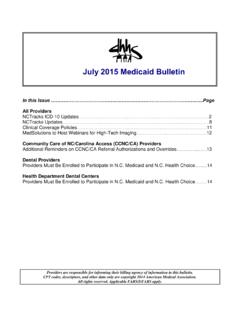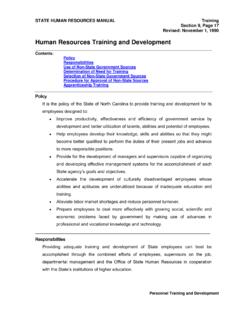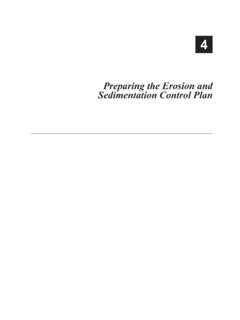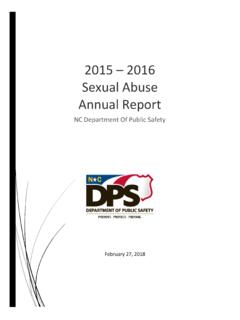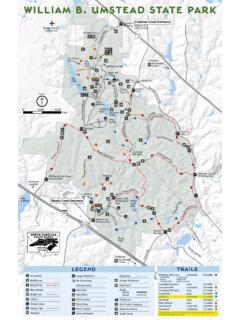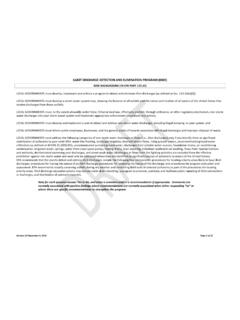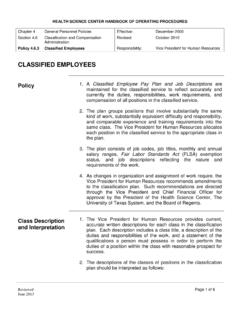Transcription of POLICY AND PROCEDURE - files.nc.gov
1 Page 1 of 8 State of North Carolina Department of Public Safety Prisons POLICY AND PROCEDURE Chapter: F Section: .1100 Title: Transporting Offenders Issue Date: 09/06/18 Supersedes: 03/26/18 .1101 General Correctional staff tasked with custodial supervision of offenders to be transported within the state act as authorized agents of the Director of Prisons. Prisons staff is vested with the authority of peace officers for this purpose. Prisons staff is responsible for the safety and security of all offenders assigned to them. This POLICY will outline procedures governing the transportation of offenders outside of the institution/facility and from one jurisdiction to another. Procedures governing the use and security of institution vehicles will also be outlined..1102 Security Precautions will be taken to maintain order and security.
2 The following provisions should not be construed as excluding the employment of additional precautions that may be necessary. (a) Each facility will maintain a written PROCEDURE establishing specific guidelines for the transport of all offenders to include those transported to outside medical facilities, court trips, funerals/private viewings, and by persons other than department or facility staff. These facility procedures shall also prohibit notification of an offender of the date, time, route and destination of the trip and the release of the information to persons not having a need to know. (b) Armed Supervision. All offenders other than those classified in minimum custody will be supervised by armed, certified correctional staff during transportation. Officers in possession of firearms will not place themselves in a position that will allow the offender to gain possession of the weapon.
3 (c) Mechanical Restraints. Handcuffs and leg cuffs will be used when the officer-in-charge of the offenders or responsible line staff deem the restraints necessary for custodial reasons. The restraints will be frequently and carefully examined. No offender classified in control status, close custody or medium custody will be transported without leg cuffs, handcuffs with black box and security chain in a non-security vehicle. If offenders classified in control status, close custody and medium custody are transported with minimum custody offenders, all offenders will be handcuffed. (d) Ballistic Body Armor. All offenders classified in close custody and medium custody that are transported outside the confines of a correctional facility shall be supervised by correctional staff wearing ballistic body armor. This body armor is to be worn on the Page 2 of 8 Chapter F.
4 1100 09/06/18 Transporting Offenders outside of the uniform shirt. Exceptions are authorized only for road squad officers and in emergency situations at the discretion of the OIC (Officer-In-Charge). (e) Searches. Offenders being transported classified in control status, close custody and medium custody will be completely searched (strip search) upon leaving and entering a close or medium security prison facility. The transporting officer shall be present while a complete search of each offender is conducted. Strip searches shall be thorough, and shall be conducted consistent with POLICY . Offenders will not be allowed to have any items that may be used as a weapon or instrument for escape. For additional specifics on searches, refer to DOP POLICY (Operational Searches). (f) Copies of security alert comments should be provided to transporting officers so that appropriate security measures can be taken to reduce the likelihood of escape and/or assault.
5 (1) Certain offenders with security alert comments may require transportation by special teams, either PERT or SORT. These offenders are usually classified on the F12 Security Alert Screen as Extreme Escape Risk. The decision for identifying these offenders and identifying the special team utilized for transport will be made in concert by the Assistant Director of Auxiliary Services and the Assistant Director of Security Accountability. (g) In the event the offender is being transported for a court appearance, the transporting officers shall be provided a copy of the court s writ prior to departing the facility in case questions arise related to the court appearance. (h) Vehicles. Vehicles used in transporting offenders will be thoroughly inspected before offenders are loaded. This inspection will insure there is no contraband, particularly which could be used to assist offenders to escape.
6 When a security vehicle is used, stops for security inspections will be accomplished frequently when offenders of a high custodial risk are being transported. When practical, offenders will be transported during daylight hours and will be kept under observation at all times while in transit. The transporting officer shall maintain continuous communication capability with facility and/or local/state law enforcement officials throughout the duration of the trip. (i) Routes. Offenders shall not be provided prior information regarding the time of departure or the route that will be taken when they are transported. Generally, the most direct route should be taken when transporting offenders. The officer-in-charge may authorize deviation from the most direct route for security reasons. Facilities with offender transfer bus routes shall maintain documentation of alternating use of their assigned primary and secondary travel routes.
7 (j) Traffic Laws. Prison staff driving vehicles must have a valid driver s license when Page 3 of 8 Chapter F .1100 09/06/18 Transporting Offenders operating a motor vehicle. All traffic laws must be followed at all times. Prison staff transporting offenders shall not travel in excess of the posted speed limit. (k) Cell Phones. Prison staff shall not carry personal cell phones while transporting offenders outside the confines of any prison facility unless authorized by the OIC. (l) Emergency Stops. Each facility shall maintain a written PROCEDURE establishing specific guidelines to follow when stopping for emergency reasons, to permit staff or offenders to use the restroom, and to manage disruptive offenders. (m) Identification.
8 Transporting officers must have a current photo, offender fact sheet and a brief description of the offender in their possession during the transport. Each offender at close and medium custody facilities will be positively identified by a picture ID prior to exiting/entering the facility. (n) Property. Offender s property will be kept separate from the offenders during transport. (o) Offenders transported by automobiles and vans must be secured in the vehicle utilizing the safety restraint system ( , seatbelts). (p) Medical Staff. Medical staff shall be notified of all planned transports to determine if there are medical impediments or if medications must accompany the offender..1103 Certified Staff to Offender Ratio (a) Custody Levels. Under normal circumstances, the following certified staff to offender ratio should be utilized in these custody categories. Based on the individual situation, additional security precautions may be authorized.
9 (1) Close Custody. Two certified staff with one or more offenders. (2) Medium Custody. One certified staff member with one offender; two certified staff with two or more offenders. (3) Minimum Custody. Staff to offender ratio shall be determined by facility head or designee. (b) Control Status. Under normal circumstances, the following certified staff to offender ratio should be utilized in these control categories. Based on the individual situation, additional security precautions may be authorized. Page 4 of 8 Chapter F .1100 09/06/18 Transporting Offenders (1) High Security Maximum Control. Two certified staff members with one offender. More than one offender will require two certified staff in the security vehicle and two certified staff in a chase vehicle.
10 (2) Restrictive Housing for Control Purposes (RHCP). Two certified staff members with one to four offenders. Five offenders and above requires a chase vehicle. (3) Death Row. Two certified staff with one offender. (4) Protective Control. Security consistent with the offender s custody level. (5) Restrictive Housing for Disciplinary Purposes (RHDP). Security consistent with the offender s custody level. (A) Offenders in regular population transferring to a facility for RHDP may be transferred on the regular transfer bus. (B) Offenders already on RHDP or RHAP that are transferring to a facility to continue restrictive housing shall not be transferred on the regular transfer bus. (6) Restrictive Housing for Administrative Purposes (RHAP). Transportation is consistent with the offender s custody level. Offenders being transferred for RHAP should not be transferred on the regular transfer bus.

